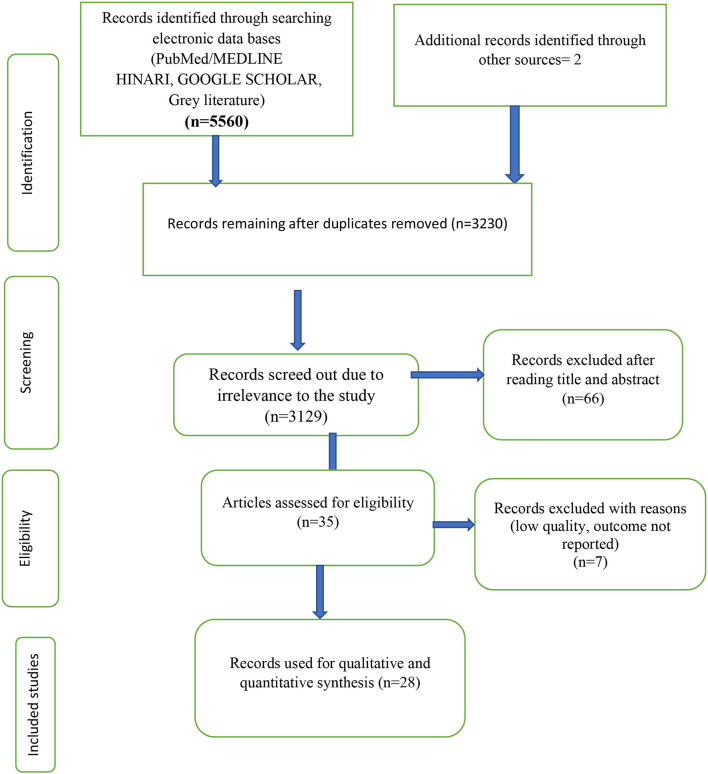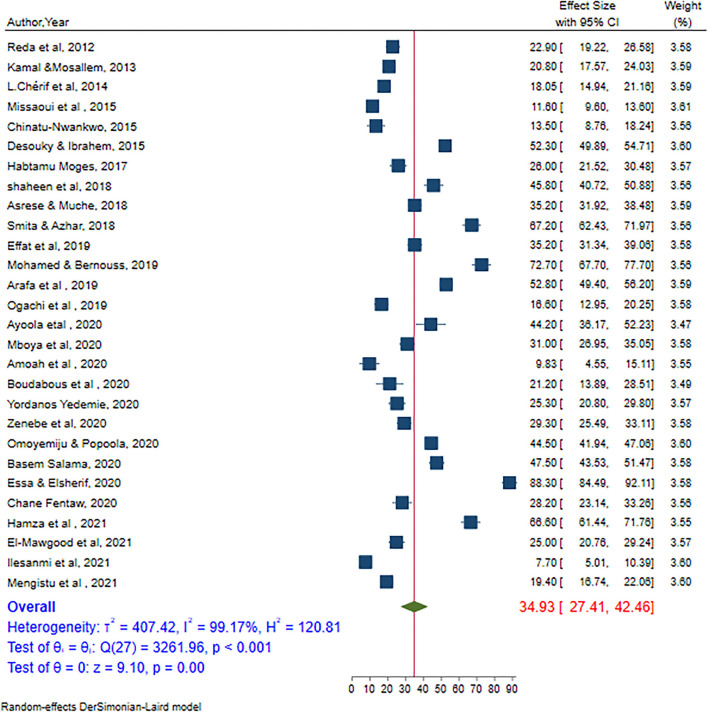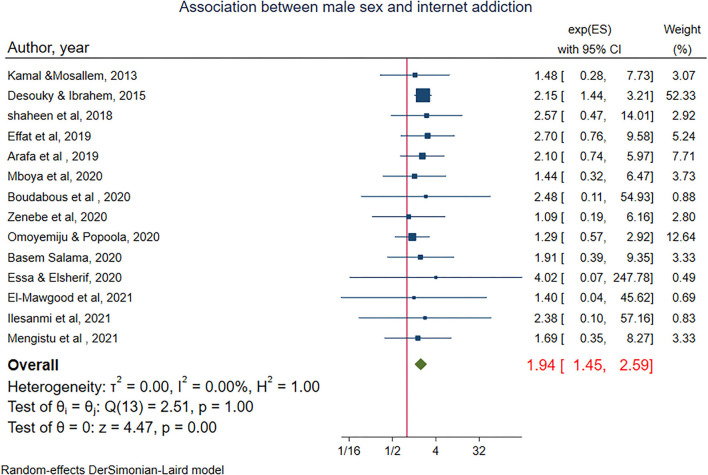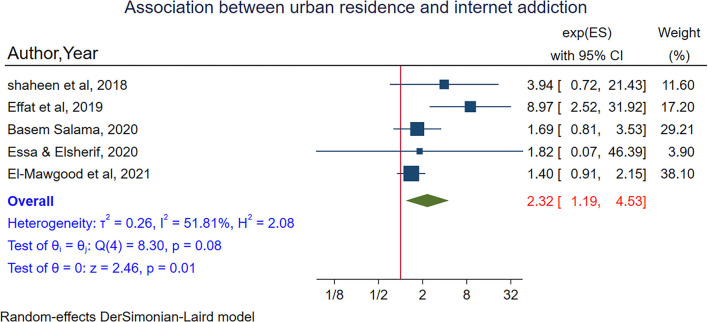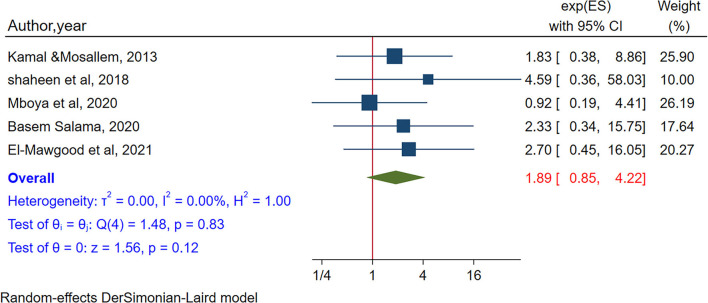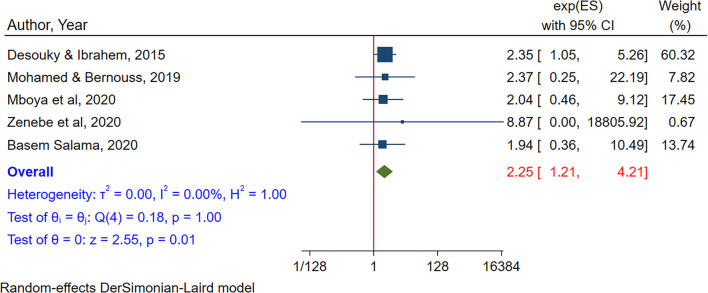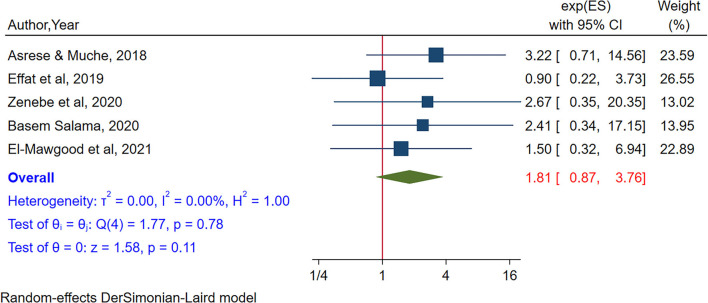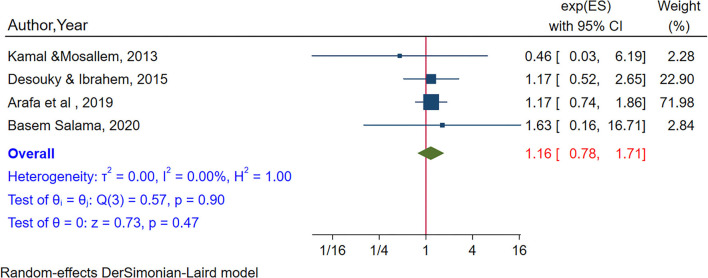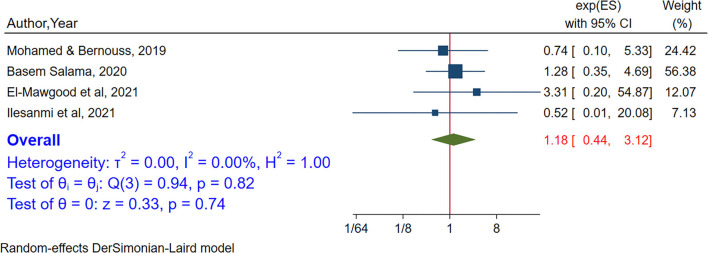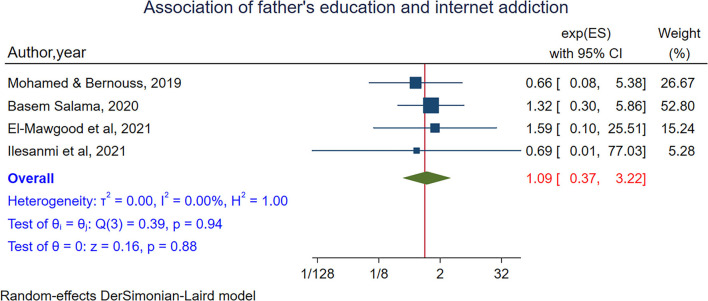Abstract
Introduction
Internet addiction is characterized by excessive and uncontrolled use of the internet affecting everyday life. Adolescents are the primary risk group for internet addiction. Data on internet addiction is lacking in Africa. Thus, this review aimed to determine the pooled prevalence of internet addiction and its associated factors among high school and university students in Africa.
Methods
A comprehensive literature search was conducted using electronic databases (PubMed/MEDLINE, Web of science, Hinari, and Google scholar) to locate potential studies. Heterogeneity between studies was checked using Cochrane Q test statistics and I2 test statistics and small-study effects were checked using Egger's statistical test at a 5% significance level. A sensitivity analysis was performed. A random-effects model was employed to estimate the pooled prevalence and associated factors of internet addiction among students. The primary outcome of measure of this review was the prevalence of internet addiction and the secondary outcome of measures are the factors associated with internet addiction.
Results
A total of 5,562 studies were identified among the five databases. Of these, 28 studies from 10 countries with 14,946 high school and university students were included in this review. The overall pooled prevalence of internet addiction among the students was 34.53% [95% Confidence Interval (CI): 26.83, 42.23, I2 = 99.20%]. Male sex [Pooled Odds Ratio (POR) = 1.92, 95% CI:1.43, 2.57 I2 = 0.00], urban residence (POR = 2.32, 95% CI:1.19, 4.53, I2 = 59.39%), and duration of daily internet use for more than 4 h (POR = 2.25, 95% CI:1.20, 4.21, I2 = 0.00%, were significantly associated with internet addiction among adolescents.
Conclusion
Almost one-third of university and high school students in Africa are addicted to the internet. Male students, those from urban areas, and those who use the internet for more than 4 h per day have higher odds of internet addiction. Thus, we recommend that health planners and policymakers pay attention to the use of the internet and internet addiction in Africa.
Keywords: internet addiction, adolescent, Africa, problematic internet use, systematic review and meta-analysis
Introduction
Internet and smartphone use has increased worldwide over the recent decades and has become a critical part of modern-day life [World Health Organization (WHO), 2014]. Statistics show that as of January 2021, the global population using the internet has grown to almost 4.6 billion (Kemp, 2021). In Africa, internet use increased from 120 million in 2014 to 270 million in 2019 (Okae and Gyasi, 2013).
Appropriate internet use is important in communications, research, socialization, entertainment, and many other benefits. However, internet use also has negative impacts, in which internet overuse has been associated with addiction and mental health issues (Chao et al., 2020).
Internet addiction is a heterogeneous problem including different online activities including online gaming, pornography, social networking, and online shopping (Nissen, 2006). Since 2013 Internet gaming disorder is included in the 11th edition of the International Classification of Diseases (ICD-11) as a clinically significant problem and in the classification of mental and behavioral disorders of the American Psychiatric Association (DSM-5) as a condition for further study (World Health Organization, 2018). Despite its heterogeneity Internet addiction does not yet exist as a diagnosis or specific disorder in either ICD-11 or DSM-5 (Musetti et al., 2016).
Internet addiction is characterized by excessive and uncontrolled use of the internet affecting everyday life (Young, 1998). The disorder is mainly associated with other psychological conditions including attention deficit hyperactivity disorder and depression (Silvia Kratzer1, 2007). The global prevalence is estimated to be 6% ranging from 2.6 % in western Europe to 10.25% in the Middle East (Cheng and Li, 2014).
Adolescents are the primary risk group for internet addiction (Öztürk and Özmen, 2016). Developmental changes in the brain during adolescence especially in cognition, stress, and motivation make these age groups more vulnerable to addictive behaviors (Casey et al., 2005; Hammond et al., 2014).
Internet addiction in adolescence can have multiple negative impacts including cognitive problems (Park et al., 2011), loneliness (Hasmujaj, 2016), poor family and interpersonal relationship problems (Seo et al., 2009; Hou et al., 2019) poor school performance (Javaeed et al., 2020; Hamza, 2021), lower self-esteem (Yedemie, 2021), lack of selfcare (Tran et al., 2017), depression (Ha et al., 2007; Guo et al., 2012; Iskender, 2014; Ansar et al., 2020), anxiety stress (Silvia Kratzer1, 2007; ElSalhy et al., 2019; Saikia et al., 2019; Boudabous et al., 2020), and obesity (Bozkurt et al., 2018; Arafa et al., 2020; Citlik-Saritas et al., 2020).
Literature shows that different factors predispose adolescents to internet addiction: including urban residence, presence of internet at home (Effat et al., 2019; Abd El-Mawgood et al., 2021), gender (Akpunne et al., 2020; Nyaga, 2020), spending more hours on the internet (Abd et al., 2017; Fantaw, 2021; Kapus et al., 2021), using internet for entertainment, pornography and online gaming (Seo et al., 2009; Asrese and Muche, 2020; Zenebe et al., 2020), and substance use (Tran et al., 2017; Zenebe et al., 2020; Kapus et al., 2021).
Even though internet addiction is becoming a global concern its assessment and criteria to define internet addicts is still a challenge (Byun et al., 2009). Despite its shortcomings, the Internet Addiction Test (IAT) is one of the most widely used tests in assessing internet addiction (Sela et al., 2021). The test has gained international acceptance and has shown to have reliability and consistency (Moon et al., 2018). Different terminologies have been used to describe internet addiction problems in different literature. “Internet addiction,” “Problematic internet use” and “pathological use of internet” are the most commonly used terminologies (Pau, 2019).
Studies have been conducted to assess the prevalence of internet addiction in different regions with inconsistent and inconclusive findings. There is no pooled systematic review and meta-analysis which assesses the prevalence of internet addiction among adolescents in Africa. Therefore, this review aims to determine the pooled prevalence of internet addiction and its associated factors among college and university students in Africa. The findings from this study can be used by health planners and policymakers to curve the prevalence of internet addiction among African students.
Methods
Study Setting and Search Strategy
Searches were conducted on PubMed/MEDLINE, Web of science, Hinari, and Google scholar. Additionally, unpublished works were reviewed from research centers and library sources. Systematic searches of all electronic databases were conducted from October to November 2021. Pre-identified search terms were used to allow a comprehensive search strategy that included all the relevant studies. Pre-identified search terms such as “Internet addiction” OR “internet addiction disorder” OR “problematic internet use” OR “cyber addict” OR “smartphone addiction” OR “social media addiction” OR “media addiction” were used.
Eligibility of Criteria
We used the CoCoPop (Condition, Context, and Population) approach for prevalence studies to declare the inclusion and exclusion criteria.
Inclusion and Exclusion Criteria
Studies reporting the prevalence of internet addiction in university and high school students in any of the African countries using Young's Internet addiction test (YIAT) were included. Additionally, full-text articles written in English were included in the review. Studies conducted on postgraduate students; studies that used tools other than YIAT were excluded.
Measurement of the Outcome Variable
The primary measure of the outcome of this review was the prevalence of internet addiction according to young's internet addiction Test. The IAT questionnaire was used as a screening tool to examine the level of Internet addiction. The tool was developed by Young and colleagues in 1996. It contains 20 items to examine symptoms of IA based on a 5-point Likert scale ranging from 0 to 5 (0 = not applicable, 1 = rarely, 2 = occasionally, 3 = frequently, 4 = often, 5 = always). According to the tool, the severity of IA is scored as follows: 20–49 points is “average Internet users”; 50–79 points are “possible problematic Internet users”; and 80– 100 points is “severe Internet addict.” The cutoff points for all studies included in this review were standardized in this review, a score below 50 was classified as “normal internet use” and a score of 50 and above was classified as “internet addiction” (Young, 1998).
The second outcome was the factors associated with internet addiction, which were determined using the odds ratio (OR) and calculated based on binary outcomes from the included primary studies.
Study Selection and Data Collection
All the studies reviewed through different electronic databases were combined, exported, and managed using Endnote version X7.2 (Thomson Reuters, Philadelphia, PA, USA) software. All duplicate studies were removed and full-text studies were downloaded using Endnote software and manually. The eligibility of each study was assessed independently by two reviewers (EA. and SA.). Subsequently, studies were screened and excluded based on their titles and abstracts. Full-text articles or reports were assessed in the remaining articles. The eligibility of the studies was evaluated based on the predetermined inclusion and exclusion criteria. Differences in the results of the two reviewers narrowed through discussion and other reviewer members (TT and GY).
Assessment of Quality of Individual Studies
Hoy quality assessment tool was used to assess the quality of the studies. It has nine questions. Based on the score of the quality assessment tool, the lowest score had the minimum risk of bias. Overall scores range from (0–3), (4–6), and (7–9), which are declared low, moderate, and high risk of bias respectively (Kirthi et al., 2021). Three reviewers independently assessed the studies (EAZ, TT, and SAT). Disagreements between them were resolved by another review team (GWA and ECA).
Data Extraction and Management
Three reviewers (EAZ, SAT, and MMA) independently extracted the data using a standardized data extraction checklist on a Microsoft Excel spreadsheet. The discrepancies between the two authors were managed by discussion and by other reviewers (TT, GYY, TAF, and FTA). For each study, authors, year of publication, region, study design, sample size, the prevalence of internet addiction with standard error, and determinant factors, with effect size and their standard error were extracted.
Statistical Analysis
After extraction, data were exported to STATA/MP version 16.0 software for analysis. The pooled prevalence of internet addiction and its associated factors were analyzed by the random-effects model using Der Simonian-Laird model weight (DerSimonian and Laird, 1986). Statistically, significant heterogeneity was assessed using the Cochrane Q-test and I2 statistics (Higgins et al., 2019). To minimize the variance of estimated points between primary studies, a subgroup analysis was carried out on the regions, economies, and target groups. A sensitivity analysis was conducted to determine the influence of single studies on pooled estimates. Univariate meta-regression was conducted using the year of publication and the mean age in the study using a random-effects model. Publication bias (small study effect) was checked graphically using a funnel plot and Egger's statistical test (Egger et al., 1997). Statistically significant Egger's test (P-value < 0.05) indicates the presence of a small study effect, and is handled by non-parametric trim and fill analysis using the random-effects model (Duval and Tweedie, 2000).
Results
Study Selection and Identification
Of the 5,562 papers searched from different databases, 2,332 duplicates were removed, and 3,129 were removed because of irrelevance to the study; again 66 papers were removed by reading the title and abstract. Finally, out of the remaining 35 papers, 7 were excluded due to low quality, the outcome not reported, and tests other than YIAT. Finally, twenty-eight papers were used for the meta-analysis (Figure 1).
Figure 1.
Prisma flow diagram of article selection for systematic review and meta-analysis on the prevalence of internet addiction and its associated factors among students in Africa.
Characteristics of Included Studies
All the included studies were cross-sectional studies. A total of 14,946 high school and university students were included in the review. The mean age was 19.44 ± 2.80 years. The minimum and the maximum ages were 14.15 and 24.4 years, respectively. The minimum prevalence (7.7 %) of internet addiction was reported in Nigeria (Ilesanmi et al., 2021). The maximum prevalence (88.3%) was reported in a study conducted in Egypt (Ebrahim Essa and Elsherif, 2020) (Table 1).
Table 1.
Characteristics of included studies in the study of review on prevalence of internet addiction and its associated factors among adolescents in Africa.
| S/N | References | Country | Region | Sample | Prevalence | Quality |
|---|---|---|---|---|---|---|
| size | of IA | score | ||||
| 1 | Reda et al., 2012 | Egypt | North Africa | 501 | 22.9 | 1 |
| 2 | Kamal and Mosallem, 2013 | Egypt | North Africa | 605 | 20.8 | 1 |
| 3 | Chérif et al., 2015 | Tunisia | North Africa | 587 | 18.05 | 1 |
| 4 | Alhajjar, 2014 | Egypt | North Africa | 1,656 | 52.3 | 2 |
| 5 | Missaoui and Brahim, 2015 | Tunisia | North Africa | 982 | 11.6 | 3 |
| 6 | Chinatu, 2015 | Nigeria | West Africa | 200 | 13.5 | 1 |
| 7 | Moges, 2017 | Ethiopia | East Africa | 369 | 26 | 1 |
| 8 | Goorah and Fuzoolla, 2018 | Mauritius | South Africa | 372 | 67.2 | 1 |
| 9 | Asrese and Muche, 2020 | Ethiopia | East Africa | 812 | 35.2 | 1 |
| 10 | Shaheen and Farahat, 2016 | Egypt | North Africa | 396 | 48.5 | 1 |
| 11 | Ogachi et al., 2019 | Kenya | East Africa | 400 | 16.6 | 3 |
| 12 | Arafa et al., 2020 | Egypt | North Africa | 828 | 52.8 | 1 |
| 13 | Effat et al., 2019 | Egypt | North Africa | 588 | 35.2 | 1 |
| 14 | Mohamed and Bernouss, 2020 | Morocco | North Africa | 305 | 72.7 | 1 |
| 15 | Yedemie, 2021 | Ethiopia | East Africa | 359 | 25.3 | 1 |
| 16 | Iluku-Ayoola et al., 2020 | Nigeria | West Africa | 147 | 44.2 | 1 |
| 17 | Ebrahim Essa and Elsherif, 2020 | Egypt | North Africa | 273 | 88.3 | 1 |
| 18 | Zenebe et al., 2020 | Ethiopia | East Africa | 548 | 29.3 | 1 |
| 19 | Boudabous et al., 2020 | Tunisia | North Africa | 120 | 21.2 | 1 |
| 20 | Mboya et al., 2020 | Tanzania | East Africa | 500 | 31 | 1 |
| 21 | Fantaw, 2021 | Ethiopia | East Africa | 304 | 28.2 | 3 |
| 22 | Amoah et al., 2020 | Ghana | West Africa | 122 | 9.8 | 3 |
| 23 | Salama, 2020 | Egypt | North Africa | 608 | 47.5 | 1 |
| 24 | Omoyemiju and Popoola, 2021 | Nigeria | West Africa | 1,448 | 44.5 | 1 |
| 25 | Ilesanmi et al., 2021 | Nigeria | West Africa | 376 | 7.7 | 1 |
| 26 | Abd El-Mawgood et al., 2021 | Egypt | North Africa | 400 | 25 | 1 |
| 27 | Study and Mengistu, 2021 | Ethiopia | East Africa | 846 | 19.4 | 1 |
| 28 | Hamza, 2021 | Sudan | East Africa | 321 | 66.6 | 1 |
The Pooled Prevalence of Internet Addiction Among Youth
In the random effects model, the pooled prevalence of internet addiction was 34.93% (95% CI = 27.41–42.45). Significant heterogeneity was observed among studies (I2 = 99.17, P-value < 0.001) (Figure 2). There was no publication bias as evidenced by Egger's test bias (β = 0.12, P-value = 0.07) (Supplementary Figure 1).
Figure 2.
The pooled prevalence of internet addiction among high school and university students in Africa.
Handling Heterogeneity
Significant heterogeneity was observed from the random-effects model. To handle this heterogeneity; sensitivity analysis, subgroup analysis, and meta-regression analysis were performed. In sensitivity analysis, there were no studies that excessively influence the pooled prevalence of internet addiction. Subgroup analysis was performed based on the region and target population, Based on the region, the highest prevalence of internet addiction was observed in a study conducted in Mauritius 63% (Goorah and Fuzoolla, 2018), and the lowest prevalence was observed in the West African region 28.37%. Based on the target population, the highest prevalence of internet addiction was observed in studies conducted among university students as compared with studies conducted among high school students, 36.93 and 28.87% respectively (Table 2).
Table 2.
Sub-group analysis for internet addiction and its associated factors among students in Africa.
| Variables | Included studies | Sample size | Prevalence (95%CI) | Heterogeneity (I2, P-value) | |
|---|---|---|---|---|---|
| By region | North Africa | 12 | 7,453 | 39.03 (25.54–52.52) | 99.48%, ≤ 0.001 |
| East Africa | 9 | 4,459 | 30.76 (22.63–38.90) | 97.47%, <0.001 | |
| West Africa | 5 | 2,293 | 23.87 (5.33–42.41) | 99.13%, <0.001 | |
| South Africa | 1 | 372 | 67.20 (62.43–71.97) | 0.00 | |
| By target group | High school | 8 | 4,584 | 28.87 (15.97–41.76) | 99.25%, <0.001 |
| University | 20 | 10617 | 36.93 (28.10–45.76) | 98.99%, <0.001 | |
| By socioeconomic status | Low income | 7 | 3,559 | 32.78 (22.83–42.74) | 97.79%, <0.001 |
| Low middle income | 19 | 10,646 | 33.45 (23.61–43.69) | 98.15%, <0.001 | |
| Upper middle income | 1 | 372 | 67.20 (62.43–71.97) | 0.00% |
Meta-Regression
Meta-regression analysis was computed to evaluate underlying sources of heterogeneity using mean age, study quality, and year of publication. No significant association was observed between internet addiction and the above-described variables (Table 3).
Table 3.
Univariate meta-regression analysis result for the prevalence of internet addiction among African college and university students.
| Study level variables | Adjusted R2 | Standard error | Coefficients (95% CI) |
|---|---|---|---|
| Mean age | 8.33 | 1.53 | 1.64 (−1.36–4.64) |
| Year of publication | 0.00 | 1.52 | 1.74 (−1.24–4.73) |
| Study quality | 0.89 | 5.91 | −10.95 (−22.15–0.64) |
CI, Confidence Interval.
Internet Addiction and Factors Associated
To examine the association of internet addiction with sex, 14 studies were included (Kamal and Mosallem, 2013; Alhajjar, 2014; Shaheen and Farahat, 2016; Effat et al., 2019; Arafa et al., 2020; Boudabous et al., 2020; Ebrahim Essa and Elsherif, 2020; Mboya et al., 2020; Salama, 2020; Zenebe et al., 2020; Abd El-Mawgood et al., 2021; Ilesanmi et al., 2021; Omoyemiju and Popoola, 2021; Study and Mengistu, 2021). Among these, 10 studies reported a significantly higher odds of internet addiction among male adolescents (Alhajjar, 2014; Shaheen and Farahat, 2016; Effat et al., 2019; Arafa et al., 2020; Boudabous et al., 2020; Ebrahim Essa and Elsherif, 2020; Salama, 2020; Ilesanmi et al., 2021; Omoyemiju and Popoola, 2021; Study and Mengistu, 2021). The pooled estimate showed a significant association between sex and internet addiction. Male adolescents are 94% more likely to have internet addiction as compared with their counterparts [POR = 1.94, 95% CI:(1.45–2.59)]. In the random-effects model, no heterogeneity was observed among studies, (I2 = 00.00%, P-value 1.0) (Figure 3). There was no small study effect as evidenced by Egger's test (P-value = 0.71). Additionally, there was no single study that excessively influences the estimate of the effect size (Supplementary Figure 2).
Figure 3.
The pooled association between sex and internet addiction.
In a meta-analysis of five studies (Shaheen and Farahat, 2016; Effat et al., 2019; Ebrahim Essa and Elsherif, 2020; Salama, 2020; Abd El-Mawgood et al., 2021), adolescents that reside in urban areas are 2 times more likely to have internet addiction as compared to those who reside in rural areas (POR = 2.32, 95% CI:1.19–4.53). Moderate heterogeneity was observed in the random-effects model (I2 = 59.39%, P-value = 0.08) (Figure 4). Egger's test showed no small study effect (P-value = 0.20) and in sensitivity analysis, no study influences the estimates (Supplementary Figure 3).
Figure 4.
The pooled association between residence and internet addiction.
To see the association between availability of internet at home, five studies were included (Kamal and Mosallem, 2013; Shaheen and Farahat, 2016; Mboya et al., 2020; Salama, 2020; Abd El-Mawgood et al., 2021). Among these studies, four (Kamal and Mosallem, 2013; Shaheen and Farahat, 2016; Salama, 2020; Abd El-Mawgood et al., 2021) studies reported significantly higher odds of internet addiction among adolescents who have internet at home. In the pooled estimate, no significant association was observed between the availability of internet at home and internet addiction (POR = 1.89, 95% CI:0.85–4.22). No heterogeneity was observed between studies (I2 = 0.00%, P-value = 0.83) (Figure 5), and no small study effect was evidenced by Egger's test (P-value = 0.33). In sensitivity analysis, no single study influences the estimates (Supplementary Figure 4).
Figure 5.
The pooled association between availability of internet at home and internet addiction.
In a meta-analysis of four studies (Alhajjar, 2014; Mboya et al., 2020; Mohamed and Bernouss, 2020; Salama, 2020), duration of internet use was found to be significantly associated with internet addiction. Adolescents who use the internet more than 4 h per day were two times more likely to have internet addiction as compared to their counterparts (POR = 2.23, 95% CI:1.19– 4.18). There was no heterogeneity between studies in the random effects model (I2 = 0.00%, P-value = 1) (Figure 6). There was no small study effect as evidenced by Egger's test (P-value = 0.88). And by sensitivity analysis, there was no study that excessively influences the pooled association between duration of internet use and internet addiction (Supplementary Figure 5).
Figure 6.
The pooled association between duration of internet use and internet addiction.
Five studies (Effat et al., 2019; Asrese and Muche, 2020; Salama, 2020; Zenebe et al., 2020; Abd El-Mawgood et al., 2021) were included to assess the pooled association between gaming and internet addiction. The pooled result showed no significant association between gaming and internet addiction (POR = 1.80, 95% CI:0.87–3.76). No heterogeneity was observed from the random effects model (I2 = 0.00%, P-value = 0.78) (Figure 7). Egger's test showed no small study effect (P-value = 0.49), and in the sensitivity analysis, there was no study that influences the estimates (Supplementary Figure 6).
Figure 7.
The pooled association between gaming and internet addiction.
To estimate the association between smoking and internet addiction, four studies were included (Kamal and Mosallem, 2013; Alhajjar, 2014; Arafa et al., 2020; Salama, 2020). No significant association was seen between smoking and internet addiction (POR = 1.16, 95% CI:0.78–1.71). No heterogeneity was observed from the random effects model (I2 = 0.00%, P-value = 0.92) (Figure 8). There was no small study effect by Egger's test (P-value = 0.88) and in sensitivity analysis, there was no single study that influences the pooled estimates (Supplementary Figure 7).
Figure 8.
The pooled association between smoking and internet addiction.
Mother's and father's educational status were assessed to estimate the association between internet addiction among adolescents and the educational status of their parents. In a meta-analysis of four studies (Mohamed and Bernouss, 2020; Salama, 2020; Abd El-Mawgood et al., 2021; Ilesanmi et al., 2021), no association was found between the educational status of mothers and internet addiction among adolescents [POR = 1.18 95% CI:(0.44–3.12)]. From random-effects model, no heterogeneity was observed between studies (I2 = 0.00%, P-value = 0.82) (Figure 9). Egger's test showed no small study effect (P-value = 0.94). In sensitivity analysis, no single study was found to influence the estimates (Supplementary Figure 8). To assess the association between fathers' educational status and internet addiction four studies were included (Mohamed and Bernouss, 2020; Salama, 2020; Abd El-Mawgood et al., 2021; Ilesanmi et al., 2021). Again, no association was found between internet addiction among adolescents and fathers' educational status (POR = 1.09 95% CI:0.36– 3.22). From random-effects model n heterogeneity was observed between studies (I2 = 0.00%, P-value = 0.94) (Figure 10). Egger's test showed no small study effect (P-value = 0.84). In sensitivity analysis, no single study was found to influence the estimates (Supplementary Figure 2).
Figure 9.
The pooled association between mothers' education and internet addiction.
Figure 10.
The pooled association between fathers' education and internet addiction.
Discussion
This review aimed to assess the prevalence of internet addiction and its associated factors among adolescents in Africa. Twenty-eight studies from 10 countries were included in the review. The overall pooled prevalence of internet addiction among adolescents was 34.53% (95% CI = 26.83–42.23). It was comparable to other meta-analyses conducted in the Gulf Countries 33% (Al-Khani et al., 2021) and Iran 31.5% (Salarvand et al., 2022). The prevalence is higher as compared to a meta-analysis conducted in China 11.3% (Li et al., 2018), South East Asia 20% (Chia et al., 2020), and with another meta-analysis conducted among health professionals 9.7% (Buneviciene and Bunevicius, 2021). The discrepancies may be due to the differences in sociodemographic background or because of the differences in the methods of assessment for internet addiction. For instance, the IAT used in this review and the review from the gulf countries is similar while for the south east Asia different internet assessment methods and cutoff points were used.
In sub-group analysis based on the economic status of the country, higher prevalence was observed in countries with upper middle income, followed by lower middle income, and lower prevalence was observed in countries of lower-income. Other studies have also shown that students with higher socioeconomic status have higher levels of internet addiction (Kayri and Günüç, 2016; Mane et al., 2018). This may be due to the reason that as the income level and GDP of countries increases the availability of smartphones and internet increases thereby increasing the prevalence of internet addiction (Bachnio et al., 2019).
In this review, male adolescents were found to have a 92% increased risk for internet addiction. There were similar findings from another review (Su et al., 2019). Different other primary studies have shown higher internet addiction among male adolescents (Ha et al., 2007; Kamal and Mosallem, 2013; Dufour et al., 2016; Liang et al., 2016; Boudabous et al., 2020; Nyaga, 2020). Gender differences can affect different addictive behaviors. Male adolescents were found to have higher addictive behaviors than females (di Nicola et al., 2017). Additionally, different studies have shown that male adolescents participate in internet pornography, gaming, and related online activities (Bruno et al., 2014; Doornwaard et al., 2016; Islam and Hossin, 2016). Which can increase addictive behaviors in male adolescents.
Again, in our review, we have found that adolescents who reside in urban areas were more likely to have internet addiction as compared with adolescents residing in rural areas. Similar findings have been reported from studies conducted elsewhere (Cao et al., 2011; Stavropoulos et al., 2013; Pawłowska et al., 2015; Karmakar, 2017). Urbanization entails increased access to internet and different determinants of addiction including psychological distress lower social interaction have been seen to be common in urban dwellers thus explaining the increase in internet addiction in urban areas (Yasuma et al., 2019; Pearlman-Avnion et al., 2020). Additionally, the pattern of internet use is different in urban areas urban students show more activities including gaming, pornography which increase the risk of addictive behaviors (Pawłowska et al., 2015).
In this review duration of internet use, more than 4 h was found to be significantly associated with internet addiction. Adolescents who stay online for more than 4 h have 2 times more risk for internet addiction. Similar findings have been reported from other studies (Tonioni et al., 2012; Beavers et al., 2015; Anusha Prabhakaran et al., 2016; Donald and Christian, 2019; Moreno-Guerrero et al., 2020). Prolonged use of internet increases the risk of addiction. Addiction and problematic use as observed from studies conducted on addiction on substances is a neuropsychological phenomenon. Neurologic pathways modulate addiction (Chou, 2005; Heilig et al., 2021). Access to substance and prolonged use of the substance has been associated with increased addictive and neurobiological behaviors (Peirce et al., 2020).
Strength and Limitations
The strength of this study was that various databases were used to search literature, and both published and unpublished studies were included in the study. All studies included have standardized tests and the same cutoff point was used for all studies. The review has limitations, The term Internet addiction is used in this review is a general term although internet users may be addicted to a variety of activities online. Again, terminologies used to describe internet addition are different in different literature. In this review, internet addiction is used to describe a score of 50 and above on the IAT, this merges the scores for severe internet addiction and problematic internet use. Furthermore, most of the studies selected for the final analysis were conducted only in some countries of Africa, which is not the true representative of the remaining countries.
Conclusion
Results from this review suggest that internet addiction is a major public health problem in Africa. Nearly, one-third of college and high school students in Africa are addicted to the internet. Male sex, urban residence, spending 4 h or more online were significantly associated with internet addiction. Based on the findings of this review, we recommend policymakers and all concerned bodies to give due attention to prevent and decrease internet addiction among the adolescent population.
Data Availability Statement
The original contributions presented in the study are included in the article/Supplementary Material, further inquiries can be directed to the corresponding author.
Author Contributions
EZ, ST, and TT involved in data conceptualization, searching critical appraisal, and statistical analysis. GA, MA, FA, GY, and TA involved study selection and quality assessment. EA, ZM, MM, TF, and MZ participated in reviewing and editing the manuscript. All authors involved in the preparation of the final manuscript and approved the final submission.
Conflict of Interest
The authors declare that the research was conducted in the absence of any commercial or financial relationships that could be construed as a potential conflict of interest.
Publisher's Note
All claims expressed in this article are solely those of the authors and do not necessarily represent those of their affiliated organizations, or those of the publisher, the editors and the reviewers. Any product that may be evaluated in this article, or claim that may be made by its manufacturer, is not guaranteed or endorsed by the publisher.
Supplementary Material
The Supplementary Material for this article can be found online at: https://www.frontiersin.org/articles/10.3389/fpsyg.2022.847274/full#supplementary-material
References
- Abd El-Mawgood A., Yousef F., Ali R. (2021). Internet addiction among secondary school students in upper Egypt. J. High. Inst. Public Heal. 51, 67–75. 10.21608/jhiph.2021.191502 [DOI] [Google Scholar]
- Abd H. I., Ali S. A., Aly S. A. (2017). Determinants of Problematic Internet Use among Secondary School Students at Zagazig City. Zagazig Nurs. J. 13:221–235. 10.21608/znj.2017.38660 [DOI] [Google Scholar]
- Akpunne B. C., Akinnawo E. O., Alakija O. A., Kumuyi D. O. (2020). Psychometric properties of young's internet addiction test in Nigeria. Int J High Risk Behav Addict. 9:1–7. 10.5812/ijhrba.91968 [DOI] [Google Scholar]
- Alhajjar B. I. (2014). Internet addiction and psychological morbidity among nursing students in Gaza-Palestine. Am. J. Appl. Psychol. 3, 99. 10.11648/j.ajap.20140304.13 [DOI] [Google Scholar]
- Al-Khani A. M., Saquib J., Rajab A. M., Khalifa M. A., Almazrou A., Saquib N. (2021). Internet addiction in Gulf countries: A systematic review and meta-analysis. J. Behav. Addict. 21, 356. 10.1556/2006.2021.00057 [DOI] [PMC free article] [PubMed] [Google Scholar]
- Amoah C., Frimpong – Manso A., Adjaottor E. S., Ayeboafo Ansah E. O., Somhlaba N. Z. (2020). Internet Addiction Among KNUST School of Medical Sciences and Dentistry (KSMD) students - a preliminary study in Ghana. J. Educ. Learn. Technol. 1, 48–60. 10.38159/jelt.2020062 [DOI] [Google Scholar]
- Ansar F., Ali W., Zareef A., Masud N., Zahab S., Iftikhar H. (2020). Internet addiction and its relationship with depression and academic performance: a cross-sectional study at a medical school in Pakistan. Int. J. Med. Stud. 8, 251–256. 10.5195/ijms.2020.740 [DOI] [Google Scholar]
- Anusha Prabhakaran M., Patel V., Ganjiwale D., Nimbalkar M. (2016). Factors associated with internet addiction among school-going adolescents in Vadodara. J. Fam. Med. Prim. Care. 5, 765. 10.4103/2249-4863.201149 [DOI] [PMC free article] [PubMed] [Google Scholar]
- Arafa S., Elaidy M. A., Hassan M. (2020). Relationship between problematic Internet use, body mass index and psychiatric morbidities in Egyptian high school adolescent students. Al-Azhar J. Pediatr. 23, 981–998. 10.21608/azjp.2020.110457 [DOI] [Google Scholar]
- Asrese K., Muche H. (2020). Online activities as risk factors for problematic internet use among students in Bahir Dar University, North West Ethiopia: a hierarchical regression model. PLoS ONE. 15, 1–24. 10.1371/journal.pone.0238804 [DOI] [PMC free article] [PubMed] [Google Scholar]
- Bachnio A., Przepiórka A., Gorbaniuk O., Benvenuti M., Ciobanu A. M., Senol-Durak E., et al. (2019). Cultural correlates of internet addiction. Cyberpsychol. Behav. Soc. Netw. 22, 258–263. 10.1089/cyber.2018.0667 [DOI] [PubMed] [Google Scholar]
- Beavers L., Bell R., Choudhury D., Guyot W., Meier R. (2015). Online time and gender perceptions of internet Addiction. 15, 84–98. 10.1057/9781137465078_3 [DOI] [Google Scholar]
- Boudabous J., Feki I., Sellami R., Baati I., Trigui D., Masmoudi J. (2020). Anxiety and problematic internet use in tunisian students. Tunisie Medicale. 98, 745–749. [PubMed] [Google Scholar]
- Bozkurt H., Özer S, Sahin S., Sönmezgöz E. (2018). Internet use patterns and Internet addiction in children and adolescents with obesity. Pediatr. Obes. 13, 301–306. 10.1111/ijpo.12216 [DOI] [PubMed] [Google Scholar]
- Bruno A., Scimeca G., Cava L., Pandolfo G., Zoccali R. A., Muscatello M. R. A. (2014). Prevalence of internet addiction in a sample of southern italian high school students. Int. J. Ment. Health Addict. 12, 708–715. 10.1007/s11469-014-9497-y [DOI] [PMC free article] [PubMed] [Google Scholar]
- Buneviciene I., Bunevicius A. (2021). Prevalence of internet addiction in healthcare professionals: systematic review and meta-analysis. Int. J. Soc. Psychiatry. 67, 483–491. 10.1177/0020764020959093 [DOI] [PubMed] [Google Scholar]
- Byun S., Ruffini C., Mills J. E., Douglas A. C., Niang M., Stepchenkova S., et al. (2009). Internet addiction: metasynthesis of 1996–2006 quantitative research. Cyberpsychol. Behav. 12, 203–207. 10.1089/cpb.2008.0102 [DOI] [PubMed] [Google Scholar]
- Cao H., Sun Y., Wan Y., Hao J., Tao F. (2011). Problematic Internet use in Chinese adolescents and its relation to psychosomatic symptoms and life satisfaction. BMC Public Health. 11, 802. 10.1186/1471-2458-11-802 [DOI] [PMC free article] [PubMed] [Google Scholar]
- Casey B. J., Tottenham N., Liston C., Durston S. (2005). Imaging the developing brain: what have we learned about cognitive development? Trends Cogn. Sci. 9, 104–110. 10.1016/j.tics.2005.01.011 [DOI] [PubMed] [Google Scholar]
- Chao C. M., Kao K. Y., Yu T. K. (2020). Reactions to problematic internet use among adolescents: inappropriate physical and mental health perspectives. Front. Psychol. 11, 1–12. 10.3389/fpsyg.2020.01782 [DOI] [PMC free article] [PubMed] [Google Scholar]
- Cheng C., Li A. Y. L. (2014). Internet addiction prevalence and quality of (real) life: A meta-Analysis of 31 nations across seven world regions. Cyberpsychol. Behav. Soc. Netw. 17, 755–760. 10.1089/cyber.2014.0317 [DOI] [PMC free article] [PubMed] [Google Scholar]
- Chérif L., Ayedi H., Hadjkacem I., Khemekhem K., Khemekhem S., Walha A., et al. (2015). Prévalence de l' usage problématique d' Internet chez les adolescents, Sfax,. Encephale. 21, 6–11. 10.1016/j.encep.2015.04.001 [DOI] [PubMed] [Google Scholar]
- Chia D. X. Y., Ng C. W. L., Kandasami G., Seow M. Y. L., Choo C. C., Chew P. K. H., et al. (2020). Prevalence of internet addiction and gaming disorders in southeast Asia: a meta-analysis. Int. J. Environ. Res. Public Health. 20, 17. 10.3390/ijerph17072582 [DOI] [PMC free article] [PubMed] [Google Scholar]
- Chinatu N. (2015). Prevalence of internet addiction among medical students in Abia State University, Uturu, Nigeria. A Med I Ca L J 0urna L Ab I A S Tat E Un I Vers I Ty Med I Ca L S Tudent S' Assoc I I. 35, 363–367. [Google Scholar]
- Chou I. (2005). Neurobiology of addiction. Nat Neurosci. 8, 2005–2005. 10.1038/nn1105-1427 [DOI] [Google Scholar]
- Citlik-Saritas S., Cevik S., Ozden G. (2020). The relationship between internet addiction and obesity in nursing students. Int. J. Caring Sci. 13, 1280–1286. 10.3389/fpsyt.2021.723355 [DOI] [PMC free article] [PubMed] [Google Scholar]
- DerSimonian R., Laird N. (1986). Meta-analysis in clinical trials. Control Clin. Trials. 7, 177–188. 10.1016/0197-2456(86)90046-2 [DOI] [PubMed] [Google Scholar]
- di Nicola M., Ferri V. R., Moccia L., Panaccione I., Strangio A. M., Tedeschi D., et al. (2017). Gender differences and psychopathological features associated with addictive behaviors in adolescents. Front. Psychiatr. 8, 2–11. 10.3389/fpsyt.2017.00256 [DOI] [PMC free article] [PubMed] [Google Scholar]
- Donald S., Christian Bhavik R.ana, Jayshree Tolani K. N. S. (2019). Prevalence of internet addiction among College students of Ahmedabad city. Int. J. Indian Psychol. 4, 35–40. 10.1136/gpsych-2021-100496 [DOI] [PMC free article] [PubMed] [Google Scholar]
- Doornwaard S. M., van den Eijnden R. J. J. M., Baams L., Vanwesenbeeck I., ter Bogt T. F. M. (2016). Lower psychological well-being and excessive sexual interest predict symptoms of compulsive use of sexually explicit internet material among adolescent boys. J. Youth Adolesc. 45, 73–84. 10.1007/s10964-015-0326-9 [DOI] [PMC free article] [PubMed] [Google Scholar]
- Dufour M., Brunelle N., Tremblay J., Leclerc D., Cousineau M. M., Khazaal Y., et al. (2016). Gender difference in internet use and internet problems among quebec high school students. Can. J. Psychiatry. 61, 663–668. 10.1177/0706743716640755 [DOI] [PMC free article] [PubMed] [Google Scholar]
- Duval S., Tweedie R. (2000). A non-parametric “trim and fill” method of accounting for publication bias in meta-analysis. J. Am. Stat. Assoc. 95, 89–98. 10.1080/01621459.2000.10473905 [DOI] [Google Scholar]
- Ebrahim Essa H., Elsherif Z. (2020). Relation between problematic internet use and mental health status of technical nursing students in Tanta City. Tanta. Sci. Nurs. J. 19, 93–119. 10.21608/tsnj.2020.131948 [DOI] [Google Scholar]
- Effat S., Azab H., Aly H., Mahmoud O. (2019). The relationship between anxiety, depression, and problematic internet use among a sample of university students in Egypt. Sohag. Med. J. 23, 169–180. 10.21608/smj.2019.41384 [DOI] [Google Scholar]
- Egger M., Smith G. D., Schneider M., Minder C. (1997). Bias in meta-analysis detected by a simple, graphical test. Br. Med. J. 315, 629–634. 10.1136/bmj.315.7109.629 [DOI] [PMC free article] [PubMed] [Google Scholar]
- ElSalhy M., Miyazaki T., Noda Y., Nakajima S., Nakayama H., Mihara S., et al. (2019). Relationships between internet addiction and clinicodemographic and behavioral factors. Neuropsychiatr. Dis. Treat. 15, 739–752. 10.2147/NDT.S193357 [DOI] [PMC free article] [PubMed] [Google Scholar]
- Fantaw C. (2021). The Relationship between Internet Addiction and Psychological Wellbeing among Addis Ababa University Main Campus Students. Prim Heal Care. 20, 11. Available online at: http://etd.aau.edu.et/handle/123456789/24061 [Google Scholar]
- Goorah S., Fuzoolla A. A. (2018). Prevalence and characteristics of internet addiction among university students in Mauritius. SM J. Case Rep. 4, 1–5. Available online at: https://www.researchgate.net/publication/323522381_Prevalence_and_Characteristics_of_Internet_Addiction_among_University_Students_in_Mauritius [Google Scholar]
- Guo J., Chen L., Wang X., Liu Y., Chui C. H. K., He H., et al. (2012). The relationship between internet addiction and depression among migrant children and left-behind children in China. Cyberpsychol. Behav. Soc. Netw. 15, 585–590. 10.1089/cyber.2012.0261 [DOI] [PubMed] [Google Scholar]
- Ha J. H., Kim S. Y., Bae S. C., Bae S., Kim H., Sim M., et al. (2007). Depression and internet addiction in adolescents. Psychopathology. 40, 424–430. 10.1159/000107426 [DOI] [PubMed] [Google Scholar]
- Hammond C. J., Mayes L. C., Potenza M. N. (2014). Neurobiology of adolescent substance use and addictive behaviors: treatment implications. Adolesc. Med. State Art. Rev. 25, 15–32. 10.1542/9781581108903-neurobiology [DOI] [PMC free article] [PubMed] [Google Scholar]
- Hamza S. B. (2021). The effects of internet addiction on the academic performance of medical students at Omdurman Islamic university : an online cross-sectional. Study. 19, 1–15. 10.21203/rs.3.rs-154768/v1 [DOI] [Google Scholar]
- Hasmujaj E. (2016). Internet addiction and loneliness among students of University of Shkodra. Eur. Sci. J. ESJ. 12, 397. 10.19044/esj.2016.v12n29p397 [DOI] [Google Scholar]
- Heilig M., MacKillop J., Martinez D., Rehm J., Leggio L., Vanderschuren L. J. M. J. (2021). Addiction as a brain disease revised: why it still matters, and the need for consilience. Neuropsychopharmacology. 46:1715–1723. 10.1038/s41386-020-00950-y [DOI] [PMC free article] [PubMed] [Google Scholar]
- Higgins J. P. T., Thomas J., Chandler J., Cumpston M., Li T., Page M. J., et al. (2019). “Cochrane handbook for systematic reviews of interventions,” in Cochrane Handbook for Systematic Reviews of Interventions.31643080 [Google Scholar]
- Hou J., Jiang Y., Chen S., Hou Y., Wu J., Fan N., et al. (2019). Cognitive mechanism of intimate interpersonal relationships and loneliness in internet-addicts: an ERP study. Addict. Behav. Rep. 10, 100209. 10.1016/j.abrep.2019.100209 [DOI] [PMC free article] [PubMed] [Google Scholar]
- Ilesanmi O. S., Afolabi A. A., Adebayo A. M. (2021). Problematic Internet Use (PIU) Among Adolescents during COVID-19 lockdown: a study of high school students in Ibadan, Nigeria. Afric. J. Inf. Commun. 21, 1–22. 10.23962/10539/31373 [DOI] [Google Scholar]
- Iluku-Ayoola O., Awogbami S. O., Agunbiade-Olu O. P., Asoh-Chika F. O. (2020). Prevalence of internet addiction and its effects on academic performance among college students in semi-urban settlement of Ijero-Ekiti, Ekiti State Nigeria. Glob. J. Eng. Technol. Adv. 05, 047–056. 10.30574/gjeta.2020.4.3.0058 [DOI] [Google Scholar]
- Iskender M. (2014). Internet addiction and depression, anxiety and stress. Int. Online J. Educ. Sci. 3, 138–148. Available online at: https://www.researchgate.net/publication/26455059031143082 [Google Scholar]
- Islam M. A., Hossin M. Z. (2016). Prevalence and risk factors of problematic internet use and the associated psychological distress among graduate students of Bangladesh. Asian J. Gambl. Issues Public Heal. 6, 1–14. 10.1186/s40405-016-0020-1 [DOI] [PMC free article] [PubMed] [Google Scholar]
- Javaeed A., Jeelani R., Gulab S., Ghauri S. K. (2020). Relationship between internet addiction and academic performance of undergraduate medical students of Azad Kashmir. Pakistan J. Med. Sci. 36, 229–233. 10.12669/pjms.36.2.1061 [DOI] [PMC free article] [PubMed] [Google Scholar]
- Kamal N. N., Mosallem F. A. E. H. (2013). Determinants of problematic internet use among El-Minia high school students, Egypt. Int J Prev Med. 4, 1429–1437. [PMC free article] [PubMed] [Google Scholar]
- Kapus K., Nyulas R., Nemeskeri Z., Zadori I., Muity G., Kiss J., et al. (2021). Prevalence and risk factors of internet addiction among hungarian high school students. Int. J. Environ. Res. Public Health. 21, 18. 10.3390/ijerph18136989 [DOI] [PMC free article] [PubMed] [Google Scholar]
- Karmakar T. (2017). A comparative study on internet use by rural and urban college students. Int. J. Adv. Res. 5, 1125–1132. 10.21474/IJAR01/3615 [DOI] [Google Scholar]
- Kayri M., Günüç S. (2016). Comparing internet addiction in students with high and low socioeconomic status levels. Addicta Turkish J. Addict. 3, 165–183. 10.15805/addicta.2016.3.0110 [DOI] [Google Scholar]
- Kemp S. (2021). Digital 2021_ Global Overview Report — DataReportal – Global Digital Insights. [Google Scholar]
- Kirthi V., Nderitu P., Alam U., Evans J., Nevitt S., Malik R. A., et al. (2021). Prevalence of retinopathy in prediabetes: Protocol for a systematic review and meta-Analysis. BMJ Open. 22, 2020–2021. 10.1136/bmjopen-2020-040997 [DOI] [PMC free article] [PubMed] [Google Scholar]
- Li L., Xu D. D., Chai J. X., Wang D., Li L., Zhang L., et al. (2018). Prevalence of Internet addiction disorder in Chinese university students: a comprehensive meta-analysis of observational studies. J. Behav. Addict. 7, 610–623. 10.1556/2006.7.2018.53 [DOI] [PMC free article] [PubMed] [Google Scholar]
- Liang L., Zhou D., Yuan C., Shao A., Bian Y. (2016). Gender differences in the relationship between internet addiction and depression: a cross-lagged study in Chinese adolescents. Comput. Hum. Behav. 63, 463–470. 10.1016/j.chb.2016.04.04335114630 [DOI] [Google Scholar]
- Mane D. S., Salunkhe D. S., Batta D. M., Agarkhedkar D. S., Kumar D. G., Bharaswadkar D. R. (2018). Internet addiction in school going adolescents of different socio economic classes in Western India. Pediatr. Rev. Int. J. Pediatr. Res. 5, 60–65. 10.17511/ijpr.2018.i02.04 [DOI] [Google Scholar]
- Mboya I. B., Leyaro B. J., Kongo A., Mkombe C., Kyando E., George J. (2020). Internet addiction and associated factors among medical and allied health sciences students in northern Tanzania: a cross-sectional study. BMC Psychol. 8, 1–8. 10.1186/s40359-020-00439-9 [DOI] [PMC free article] [PubMed] [Google Scholar]
- Missaoui S. G., Brahim T. (2015). Prevalence and consequences of internet addiction in a cohort of tunisian adolescents: a pilot study. J. Child Adolesc. Behav. 15, 03. 10.4172/2375-4494.1000257 [DOI] [Google Scholar]
- Moges H. (2017). The Correlation Between Internet Addiction, Loneliness And Self -Esteem Among Addis Ababa University Students.35241939 [Google Scholar]
- Mohamed G., Bernouss R. (2020). A cross-sectional study on Internet addiction among Moroccan high school students, its prevalence and association with poor scholastic performance. Int. J. Adolesc. Youth. 25, 479–490. 10.1080/02673843.2019.1674165 [DOI] [Google Scholar]
- Moon S. J., Hwang J. S., Kim J. Y., Shin A. L., Bae S. M., Kim J. W. (2018). Psychometric properties of the internet addiction test: a systematic review and meta-analysis. Cyberpsychol. Behav. Soc. Network. 18, 473–484. 10.1089/cyber.2018.0154 [DOI] [PubMed] [Google Scholar]
- Moreno-Guerrero A. J., Gómez-García G., López-Belmonte J., Rodríguez-Jiménez C. (2020). Internet Addiction in the Web of Science Database: A Review of the Literature with Scientific Mapping. International Journal of Environmental Research and Public Health. 17, 2753. 10.3390/ijerph17082753 [DOI] [PMC free article] [PubMed] [Google Scholar]
- Musetti A., Cattivelli R., Giacobbi M., Zuglian P., Ceccarini M., Capelli F., et al. (2016). Challenges in internet addiction disorder: Is a diagnosis feasible or not? Front. Psychol. 7, 1–8. 10.3389/fpsyg.2016.00842 [DOI] [PMC free article] [PubMed] [Google Scholar]
- Nissen J. B. (2006). Treating and preventing adolescent mental health disorders. what we know and what we don't know. Acta. Psychiatr. Scand. 113, 518–518. 10.1111/j.1600-0447.2006.00765.x [DOI] [Google Scholar]
- Nyaga K. (2020). Prevalence of pathological internet use among adolescents in secondary schools: a case of ruthimitu mixed and dagoretti mixed sub-county secondary schools in nairobi County, Kenya Kimaru. African J. Clin. Psychol. 20, 03. Available online at: https://www.daystar.ac.ke/ajcp/articles/abstract/Nicholas%20Nyaga1.html [Google Scholar]
- Ogachi F. M., Karega M., Oteyo J. S. (2019). Relationship between depression and pathological internet use among university students. Cypriot. J. Educ. Sci. 14, 201–207. 10.18844/cjes.v14i2.3123 [DOI] [Google Scholar]
- Okae P., Gyasi K. (2013). Internet penetration in africa compared to the rest of the world 2. What Users Use the Intern. 3, 24–28. 10.5923/j.computer.20130302.0222499009 [DOI] [Google Scholar]
- Omoyemiju M. A., Popoola B. I. (2021). Prevalence of internet addiction among university students in Nigeria. Br. J. Guid. Couns. 49, 132–139. 10.1080/03069885.2020.172933926130501 [DOI] [Google Scholar]
- Öztürk E., Özmen S. K. (2016). The relationship of self-perception, personality and high school type with the level of problematic internet use in adolescents. Comput. Hum. Behav. 65, 501–507. 10.1016/j.chb.2016.09.016 [DOI] [Google Scholar]
- Park M. H., Park E. J., Choi J., Chai S., Lee J. H., Lee C., et al. (2011). Preliminary study of Internet addiction and cognitive function in adolescents based on IQ tests. Psychiatr. Res. 190, 275–281. 10.1016/j.psychres.2011.08.006 [DOI] [PubMed] [Google Scholar]
- Pau L.-F. (2019). Internet addictions and problematic use of the internet: terminology and causalities. SSRN Electron J. 19, 56. 10.2139/ssrn.3492727 [DOI] [Google Scholar]
- Pawłowska B., Zygo M., Potembska E., Kapka-Skrzypczak L., Dreher P., Kedzierski Z. (2015). Prevalence of Internet addiction and risk of developing addiction as exemplified by a group of Polish adolescents from urban and rural areas. Ann. Agric. Environ. Med. 22, 129–136. 10.5604/12321966.1141382 [DOI] [PubMed] [Google Scholar]
- Pearlman-Avnion S., Goldschmidt Y., Shamis N. (2020). Impacts of Urbanization and ICT Use on Loneliness Among the Elderly in Israel. Educ. Urban Soc. 52, 962–983. 10.1177/0013124519891998 [DOI] [Google Scholar]
- Peirce J. M., Schacht R. L., Brooner R. K. (2020). The effects of prolonged exposure on substance use in patients with posttraumatic stress disorder and substance use disorders. J. Trauma Stress. 33, 465–476. 10.1002/jts.22546 [DOI] [PubMed] [Google Scholar]
- Reda M., Rabie M., Mohsen N., Hassan A. (2012). Problematic internet users and psychiatric morbidity in a sample of egyptian adolescents. Psychology. 03, 626–631. 10.4236/psych.2012.38096 [DOI] [Google Scholar]
- Saikia A. M., Das J., Barman P., Bharali M. D. (2019). Internet addiction and its relationships with depression, anxiety, and stress in urban adolescents of Kamrup District, Assam. J. Fam. Commun. Med. 26, 108–112. 10.4103/jfcm.JFCM_93_18 [DOI] [PMC free article] [PubMed] [Google Scholar]
- Salama B. (2020). Prevalence and associated factors of Internet addiction among undergraduate students at Al-Beheira Governorate, Egypt. Int. J. Public Health. 65, 905–910. 10.1007/s00038-020-01429-9 [DOI] [PubMed] [Google Scholar]
- Salarvand S. N., Albatineh A., Dalvand S., Baghban Karimi E., Ghanei Gheshlagh R. (2022). Prevalence of internet addiction among iranian university students: a systematic review and meta-analysis. Cyberpsychol. Behav. Soc. Netw. 22, 569. 10.1089/cyber.2021.0120 [DOI] [PubMed] [Google Scholar]
- Sela Y., Bar-Or R. L., Kor A., Lev-Ran S. (2021). The Internet addiction test: Psychometric properties, socio-demographic risk factors and addictive co-morbidities in a large adult sample. Addict. Behav. 122, 107023. 10.1016/j.addbeh.2021.107023 [DOI] [PubMed] [Google Scholar]
- Seo M., Kang H. S., Yom Y. H. (2009). Internet addiction and interpersonal problems in Korean Adolescents. CIN Comput. Inform. Nurs. 27, 226–233. 10.1097/NCN.0b013e3181a91b3f [DOI] [PubMed] [Google Scholar]
- Shaheen H. M., Farahat T. M. (2016). Problematic internet use among medical school students in Menoufia University Egypt. J. Child. Adolesc. Behav. 16, 4. 10.4172/2375-4494.1000298 [DOI] [Google Scholar]
- Silvia Kratzer1 U. H. (2007). Is “internet addiction” a disorder of its own? a study on subjects with excessive internet use. Psychiat. Prax. 35:1–10. 10.1055/s-2007-970888 [DOI] [PubMed] [Google Scholar]
- Stavropoulos V., Alexandraki K., Motti-Stefanidi F. (2013). Recognizing internet addiction: prevalence and relationship to academic achievement in adolescents enrolled in urban and rural Greek high schools. J. Adolesc. 36, 565–576. 10.1016/j.adolescence.2013.03.008 [DOI] [PubMed] [Google Scholar]
- Study A. C., Mengistu N. (2021). Internet addiction and its associated factors among Dilla University Undergraduate. Students. 21, 1–17. 10.21203/rs.3.rs-432680/v134925933 [DOI] [Google Scholar]
- Su W., Han X., Jin C., Yan Y., Potenza M. N. (2019). Are males more likely to be addicted to the internet than females? A meta-analysis involving 34 global jurisdictions. Comput. Hum. Behav. 99, 86–100. 10.1016/j.chb.2019.04.021 [DOI] [Google Scholar]
- Tonioni F., D'Alessandris L., Lai C., Martinelli D., Corvino S., Vasale M., et al. (2012). Internet addiction: Hours spent online, behaviors and psychological symptoms. Gen. Hosp. Psychiatr. 34, 80–87. 10.1016/j.genhosppsych.2011.09.013 [DOI] [PubMed] [Google Scholar]
- Tran B. X., Huong L. T., Hinh N. D., Nguyen L. H., Le B. N., Nong V. M., et al. (2017). A study on the influence of internet addiction and online interpersonal influences on health-related quality of life in young Vietnamese. BMC Publ Health. 17, 1–8. 10.1186/s12889-016-3983-z [DOI] [PMC free article] [PubMed] [Google Scholar]
- World Health Organization (WHO) . (2014). Public Health Implications of Excessive Use of the Internet, Computers, Smartphones and Similar Electronic Devices Meeting report. [Google Scholar]
- World Health Organization . (2018). “Inclusion of “gaming disorder” in ICD-11,” in: 16 January [Internet]. (2018), pp. 2018–2019. Available: https://www.who.int/news/item/14-09-2018-inclusion-of-gaming-disorder-in-icd-11 (accessed Febuary 1, 2022).
- Yasuma N., Watanabe K., Nishi D., Ishikawa H., Tachimori H., Takeshima T., et al. (2019). Urbanization and Internet addiction in a nationally representative sample of adult community residents in Japan: a cross-sectional, multilevel study. Psychiatr. Res. 273, 699–705. 10.1016/j.psychres.2019.01.094 [DOI] [PubMed] [Google Scholar]
- Yedemie Y. Y. (2021). Internet use patterns, internet addiction and its association with psychological self-esteem. Qual. Prim. Care. 29, 27–35. Available online at: https://www.iomcworld.org/open-access/associations-of-psychological-distress-sleep-pattern-and-selfesteem-among-university-adolescents-implication-for-psychological-int-65224.html [Google Scholar]
- Young K. S. (1998). Internet addiction: the emergence of a new clinical disorder. Cyberpsychol. Behav. 1, 237–244. 10.1089/cpb.1998.1.237 [DOI] [Google Scholar]
- Zenebe Y., Kunno K., Mekonnen M., Bewuket A., Birkie M., Necho M., et al. (2020). Prevalence and related factors of internet addiction among undergraduate university students in Ethiopia. Commun. Univ. Based Cross-Sect. Study. 20, 2119. 10.21203/rs.2.21929/v1 [DOI] [PMC free article] [PubMed] [Google Scholar]
Associated Data
This section collects any data citations, data availability statements, or supplementary materials included in this article.
Supplementary Materials
Data Availability Statement
The original contributions presented in the study are included in the article/Supplementary Material, further inquiries can be directed to the corresponding author.



